MODELLING WITH PUTTY
|
|
|
Index |
|
|
|
Index |
Green Putty
| The first step in producing good models or serious conversion is to get hold of some green putty. This is the stuff that is actually used by Games Workshop to produce the original of each figure. It is an epoxy putty similar to the widely used Milliput, however it has very different characteristics when used for modelling. It is much stickier and stretchier than Milliput, and it also does not have Milliput's unfortunate tendency to crumble when wet. Unfortunately it is far more expensive. You can get it from Games Workshop by mail order or in their shops. |
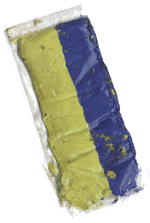
|
Modelling Tools
Knife blade - Very useful for cutting and smoothing the putty. Needle - The sharp end is more delicate than a pin's and the other end is curved about right for doing bits like faces and folded cloth. Pins - The blunt end can be used for gentle concave curves like flowing robes. Other Tools - You can also buy special tools for working clay and putty from some craft shops. Alternatively make your own. I used the plastic tube from a cotton bud, two pins, and some Milliput to make a handy two ended tool, by sticking the pins into the ends of the tube and securing them with putty. I then filed one of the pins off to make a blunt point and left the other sharp.
![]()
SCRATCH-BUILDING A FIGURE
It is best to start by making a creature such as a goblin rather than a normal person. If you make any
part of a human the wrong size or shape, particularly the head, then it will be immediately obvious but
since goblins are all twisted and malproportioned anyway, it is easier to get away with mistakes.
Armature TIP
2) Make the second leg by twisting another piece of wire around the waist.
Glue it into position and then cut off the wire after measuring it down to the end of the first leg,
remembering to allow extra for the foot. Also leave a small amount of wire sticking out of the
bottom of the foot which can be used to stick the figure to a base.
3) Make the arms by cutting a length to make both hands, both arms and the shoulders. This will be about XXmm for a standard figure. Wrap the centre around the body and glue it in place. Then twist small loops for the hands.
Note: Use pliers to grip limbs just above the joint when you position the limbs. This makes sure you get a nice tight angle so that the figure doesn't have 'bendy bones'.
Roughing it out
Leave a small gap between each of the areas mentioned above, so that the figure can still be bent at all the main anatomical joints.
Fixing the pose
The next stage is to wrap a small quantity of putty around each joint, so that the limbs become completely wrapped
in putty and the position of the figure can no longer be altered.
Adding the detail
EXAMPLES
This is a difficult and timing consuming job. To fully build a figure from scratch will take about a day, and your first few
are likely to be pretty poor. But don't let that discourage you. There is nothing more satisfying than being asked where
you got a figure and being able to say breezily 'Oh, I just scratch built it.'
Making the armature
The first step is to make a wire stick man to stick the putty around. I use thin, plastic coated electrical wire, it contains a single strand
of copper, and the coated wire is just over a millimetre in diameter. It is easy to bend and glue, with just enough stiffness to give the
required support. When making your stick-man, have a couple of figures handy to compare it to, so that you can check whether you
have the correct proportions.
(Bizarre but true)
The best place to get this wire is to find it. Just look at the bottom of lampposts or junction boxes
in the street and there are likely to be little scraps dropped by electricians.
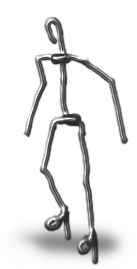
1) Twist the wire into a loop to form the head. Mark the wire off where the waist is, but continue it down to the end of the leg. Twist another small loop for the foot and leave about a centimetre sticking down out of the base of the heel.
If you try to make an entire body component in one go, you will find it extremely difficult to maintain the
overall shape while modelling the surface detail. It is therefore best to model the entire figure as an approximate
shape first before starting on the fine detail.
Points to remember
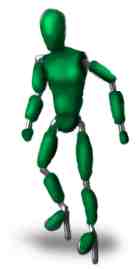
Start by modelling the following areas.
Wait until the putty has set before adjusting the figure into its final pose. The putty will ensure that your figure does not suffer from
'tentacle arms' as it will bend only in the right places at the joints between bones.
I usually start with the head, then move onto the torso, and then do the limbs one by one. Let each
small section harden (if you are in a hurry then heat it as mentioned in the tips) before going on to the next. Keep
comparing your figure to other models to ensure that you are getting the scale right.
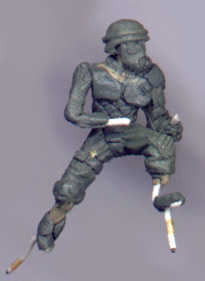
|
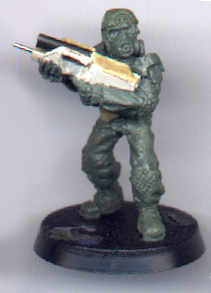
|
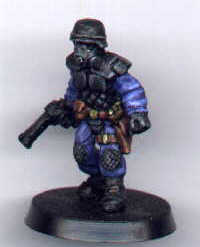
|
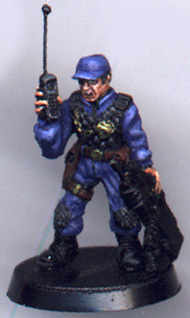
| |||
| This figure is only half complete. The head and body have been sculpted, but one arm has only been roughed out, and the boots remain to be done. Note the small traces of Milliput showing round the neck and feet, which was used to rough out some of the initial shape. | This armed policeman is very nearly complete. The weapon is made from card, Milliput, a small piece of sprue for the grenade launcher barrel and a pin for part of the muzzle. | A finished model. You may find that getting the overall proportions of the model correct is actually more difficult than producing good looking detail. In this example the waist is slightly too low, making the legs too small compared to the rest of the body. These mistakes tend to only become evident later on when it is too late to alter them. | The quilted armour on this squad leader was created by cutting a grid of grooves with a knife and then pressing the blunt end of a needle into each intersection. |
LITTLE TRICKS AND TIPS
Mixing the Putty
Gluing
Heating the putty
Making chain mail
Making chain
WORKING WITH MILLIPUT
Getting smooth surfaces
Making weapon blades
Don't try to do too much at once
Only work on small areas at a time, otherwise you will suffer the extreme frustration of accidentally crushing a freshly finished
area, whilst working on another.
Ensure that you mix the putty very thoroughly, or the setting time will increase dramatically. An easy way to do this with
small quantities is to roll it into a sausage and then twist it. (This only works with green putty, Milliput is too crumbly).
If you are having difficulty getting a blob of putty to stick to the model, then use a tiny dab of superglue in the middle of the area
and press the putty onto it. You can then work the putty onto the model with the centre of it held firmly in place.
Putty can take several hours to harden at room temperature, but if you put a normal desk lamp a few centimetres from the model, the heat will set the putty within about quarter of an hour. Great for impatient modellers.
To get the inter-linked rings look, work across the area in rows, pushing the pin in to make little holes. On each hole, slightly drag
the pin in the opposite direction to the one that you are creating the holes in. Each time you reach the end of a row, change direction for the next row. It should look a bit like rows of Cs, with alternate rows pointing in opposite directions.
This is extremely difficult and time consuming, but this is how it can be done.![]()
Press it in with a knife to create a shape like this.![]()
Push a needle tip into each wide section.![]()
Stick a tiny ball of putty onto each narrow section and then drag the ends into the holes created in the previous step.
There are a number of problems that Milliput has as a medium for creating figures. It is somewhat
difficult to describe why, but if you use both types of putty, you will soon understand the difference.
Basically Milliput breaks apart easier, is less stretchy, and also less sticky.
However, it is not without its uses. It is good for:
Milliput tends to create a rough and grainy surface, but you can avoid this in two ways.
First, when working the putty, damp your tools slightly to stop it sticking to them. Do this
sparingly because the putty soaks up the water and will eventually become soggy and crumbly.
When the figure is finished, take a very old brush and after damping it, gently brush the
putty. This will smooth it and remove the tiny crumbs of putty that tend to collect on the surface.
Roll out the Milliput into a flat sheet, roughly the size of the weapon and let it harden. You can then
use a sharp blade to cut and scrape it into the right shape. (Green putty is too rubbery to allow this to
be easily done). Finally file or sandpaper the surfaces flat.
This can also be used to make the basic shape of a gun, which can then be detailed by sticking on small
bits of green putty.
![]()
©1999. All rights reserved.
![]()